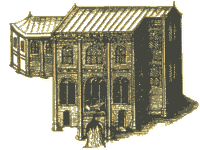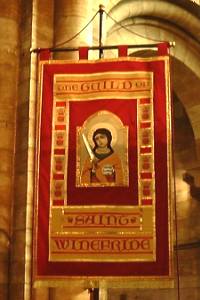Tradition says that a prince of that country named Caradoc (Caradog of Hawarden or Penarlag or Tegeingl in Flintshire) fell violently in love with her. One day, after her parents had gone to Mass, he found her alone in the house, preparing things for use at the altar. He tried to seduce her, but Winefride told him she was already espoused to another. Despite her rejection, he would not leave her alone.
Sensing his evil intentions, she excused herself, saying that she must first adorn herself more becomingly. Once she was out of his sight, she escaped through her own chamber at the rear of the house and fled toward the church. The prince, tired of waiting and suspectingsome kind of deceit, looked out of the house and saw her hurrying along the valley.
Violently angry at being deceived, he mounted his horse but was not able to overtake Winifred until she reached the door of the church. Infuriated, he raised his sword and struck her before she could enter. Hearing the tumult outside, Saint Beuno and her parents rushed out immediately and found Winifred slain.
The saint cursed Caradoc, and some writers say that the ground opened and swallowed him up, others that he melted into the ground. Then Beuno prayed, and God restored Winifred to life. It was on this spot where her blood had flowed that a fountain gushed forth from the ground. On account of this blood-shedding she was always regarded as a martyr, though she lived for many years thereafter.
 The spot became known as Holywell, a place of pilgrimage for many succeeding ages. At Holywell such vast quantities of water spring without interruption that it is estimated 24 tons are raised every minute, and the water is always crystal clear. The spot became known as Holywell, a place of pilgrimage for many succeeding ages. At Holywell such vast quantities of water spring without interruption that it is estimated 24 tons are raised every minute, and the water is always crystal clear.
After the death of Saint Beuno, Saint Winefride took the veil and went to live at the convent she established at Guthurin (Gwytherin in Denbigshire); there, with other holy virgins, she gave her life to God. (Another version says she succeeded Abbess Tenoi at the convent of a double monastery already on the site.)
She died on June 24, c. 680. (Her story was recorded by a monk named Elerius as early as 660, but judging by the names of her contemporaries, she probably lived and died in the first half of the 7th century).
In 1131 the Cistercians founded a monastery at Basingwerk nearby. The monks probably had charge of the well, though the spot was a place of pilgrimage long before that time. No place was more famous for pilgrimages, where divine mercy was implored through the intercession of Saint Winefride, who at that spot had glorified God and sanctified her own soul. Many extraordinary physical cures of leprosy, skin diseases, and other ailments are recorded up to the time of the Reformation, and part of the beautiful Gothic building erected by Henry VII and his mother, the Countess of Derby, still remains. Pilgrimages to Saint Winefride's Well continued after the Reformation, and Gerard Manley Hopkins' poem "The Leaden Echo and the Golden Echo (Maiden's song from St. Winefride's Well)" is devoted to her.
In 1138 her relics were taken from Guthurin to Shrewsbury and deposited with great honor in the Benedictine Abbey that had been founded there some 50 years earlier. Her cult then spread to England as well. Miracles were attested at Guthurin, Shrewsbury, as well as at Holywell (aka Treffynnon, Welltown). She is venerated at Holywell, Wales, and is reputed to have been Abbess of Gwytherin, Denbighshire.
 In art Winefride is depicted as a Celtic maiden with a sword, fountain at her feet, and red ring around her neck where her head has been severed and restored. Sometimes she is shown with her head being restored by Saint Beuno, at others as an abbess with a ring around herneck, standing near the fountain. In art Winefride is depicted as a Celtic maiden with a sword, fountain at her feet, and red ring around her neck where her head has been severed and restored. Sometimes she is shown with her head being restored by Saint Beuno, at others as an abbess with a ring around herneck, standing near the fountain.
Saint Winifred's Fate |